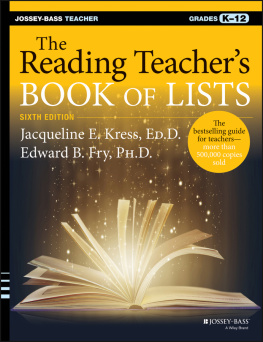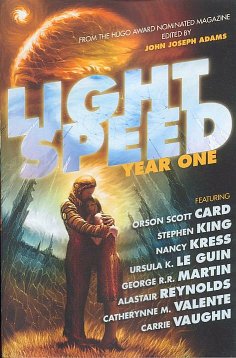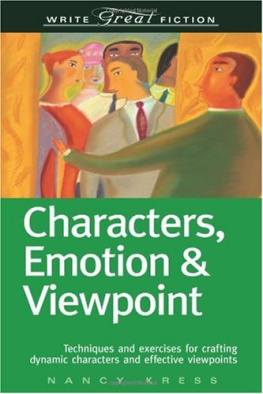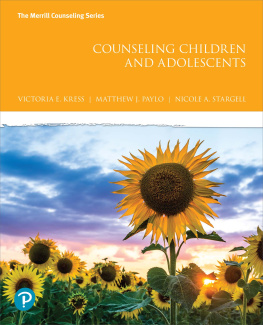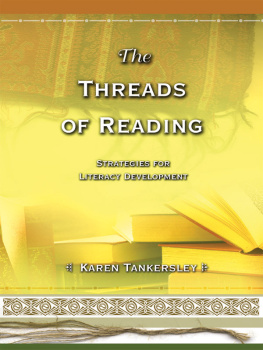
Praise for The Reading Teacher's Book of Lists, 6th Ed.
This comprehensive, invaluable volume should be in the hands of those involved in literacy instruction, those who examine the varied components of language, and those who revel in the sheer joy of language.
Bonnie Johnson, Ph.D., Co-Editor, The Reading Professor, an International Literacy Association SIG journal
The Reading Teacher's Book of Lists is a treasure box for reading professionals with some shiny new baubles. The sixth edition adds resources from technology, academic vocabulary, and the Common Core State Standards to an updated compendium of essential lists, making it a must have for literacy educators at all levels.
Camille Blachowicz, Ph.D., Co-director, The Reading Leadership Institute, National-Louis University
Teachers and parents must rush to get a copy of this fabulous resource, which will fuel every student's love of language and ensure success in reading and learning.
Diane Lapp, Ed.D., Distinguished Professor of Education, San Diego State University
Copyright 2016 by Jacqueline E Kress.
Published by Jossey-Bass
A Wiley Brand
One Montgomery Street, Suite 1000, San Francisco, CA 94104-4594www.josseybass.com
No part of this publication may be reproduced, stored in a retrieval system, or transmitted in any form or by any means, electronic, mechanical, photocopying, recording, scanning, or otherwise, except as permitted under Section 107 or 108 of the 1976 United States Copyright Act, without either the prior written permission of the publisher, or authorization through payment of the appropriate per-copy fee to the Copyright Clearance Center, Inc., 222 Rosewood Drive, Danvers, MA 01923, 978-750-8400, fax 978-646-8600, or on the Web at www.copyright.com. Requests to the publisher for permission should be addressed to the Permissions Department, John Wiley & Sons, Inc., 111 River Street, Hoboken, NJ 07030, 201-748-6011, fax 201-748-6008, or online at www.wiley.com/go/permissions.
Permission is given for individual classroom teachers to reproduce the pages and illustrations for classroom use. Reproduction of these materials for an entire school system is strictly forbidden.
Limit of Liability/Disclaimer of Warranty: While the publisher and author have used their best efforts in preparing this book, they make no representations or warranties with respect to the accuracy or completeness of the contents of this book and specifically disclaim any implied warranties of merchantability or fitness for a particular purpose. No warranty may be created or extended by sales representatives or written sales materials. The advice and strategies contained herein may not be suitable for your situation. You should consult with a professional where appropriate. Neither the publisher nor author shall be liable for any loss of profit or any other commercial damages, including but not limited to special, incidental, consequential, or other damages. Readers should be aware that Internet Web sites offered as citations and/or sources for further information may have changed or disappeared between the time this was written and when it is read.
Jossey-Bass books and products are available through most bookstores. To contact Jossey-Bass directly call our Customer Care Department within the U.S. at 800-956-7739, outside the U.S. at 317-572-3986, or fax 317-572-4002.
Wiley publishes in a variety of print and electronic formats and by print-on-demand. Some material included with standard print versions of this book may not be included in e-books or in print-on-demand. If this book refers to media such as a CD or DVD that is not included in the version you purchased, you may download this material at http://booksupport.wiley.com. For more information about Wiley products, visit www.wiley.com.
Library of Congress Cataloging-in-Publication Data is Available:
ISBN 978-1-119-08105-0 (Paper)
ISBN 978-1-119-08089-3 (ePDF)
ISBN 978-1-119-08093-0 (ePUB)
Cover Design: Wiley
Cover Image: Yuri_Arcurs/iStockphoto.com
Common Core State Standards
College and Career Readiness Anchor Standards for English Language Arts
| Foundation Skills | List Numbers |
| Print Concepts |
| 1 | Demonstrate understanding of the organization and basic features of print. | 1, 6, 7, 12, 86, 87 |
| Phonological Awareness |
| 2 | Demonstrate understanding of spoken words, syllables, and sounds (phonemes). | 1, 2, 3, 4, 8, 9, 10, 11, 12, 16, 17, 18, 22, 177, 179, 180, 202, 203 |
| Phonics and Word Recognition |
| 3 | Know and apply grade-level phonics and word analysis skills in decoding words. | 1, 3, 4, 11, 12, 16, 17, 18, 19, 20, 21, 22, 23, 24, 25, 26, 27 |
| Fluency |
| 4 | Read with sufficient accuracy and fluency to support comprehension. | 1, 3, 4, 5, 6, 25, 26, 28, 38, 115, 116, 117, 118, 119, 120, 121 |
| Author Standards for Reading | List Numbers |
| Key Ideas and Details |
| 1 | Read closely to determine what the text says explicitly and to make logical inferences from it; cite specific textual evidence when writing or speaking to support conclusions drawn from the text. | 96, 100, 102, 103, 104, 106, 108, 121 |
| 2 | Determine central ideas or themes of a text and analyze their development; summarize the key supporting details and ideas. | 96, 100, 101, 102, 103, 104, 106, 108 |
| 3 | Analyze how and why individuals, events, and ideas develop and interact over the course of a text. | 6, 96, 100, 103, 104, 106, 108, 109, 110, 141, 142, 143 |
| Craft and Structure |
| 4 | Interpret words and phrases as they are used in a text, including determining technical, connotative, and figurative meanings, and analyze how specific word choices shape meaning or tone. | 9, 36, 37, 39, 40, 65, 66, 67, 68, 69, 70, 71, 72, 73, 74, 75, 76, 77, 78, 79, 80, 81, 82, 83, 84, 85, 101, 103, 104, 109, 110, 141, 142, 143 |
| 5 | Analyze the structure of texts, including how specific sentences, paragraphs, and larger portions of the text (e.g., a section, chapter, scene, or stanza) relate to each other and the whole. | 86, 87, 103, 104, 106, 108, 138, 144, 145, 230, 231, 232, 237, 238 |
| 6 | Assess how point of view or purpose shapes the content and style of a text. | 103, 104, 108, 111, 138 |
| Integration of Knowledge and Ideas |
| 7 | Integrate and evaluate content presented in diverse media and formats, including visually and quantitatively, as well as in words. | 6, 96, 106, 109, 110, 141, 142, 143, 226, 227, 233, 234, 235, 236 |
| 8 | Delineate and evaluate the argument and specific claims in a text, including the validity of the reasoning as well as the relevance and sufficiency of the evidence. | 96, 103, 104, 106, 108, 113 |
| 9 | Analyze how two or more texts address similar themes or topics in order to build knowledge or to compare the approaches the authors take. | 87, 103, 104, 106, 108, 229 |
| Range of Reading and Level of Text Complexity |
| 10 | Read and comprehend complex literary and informational texts independently and proficiently. | 3, 4, 5, 6, 87, 88, 89, 91, 94, 99, 164 |
| Author Standards for Reading | List Numbers |
| Text Types and Purposes |
Next page
